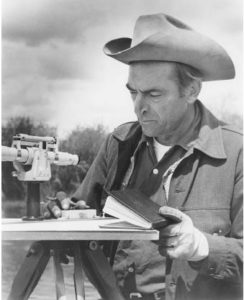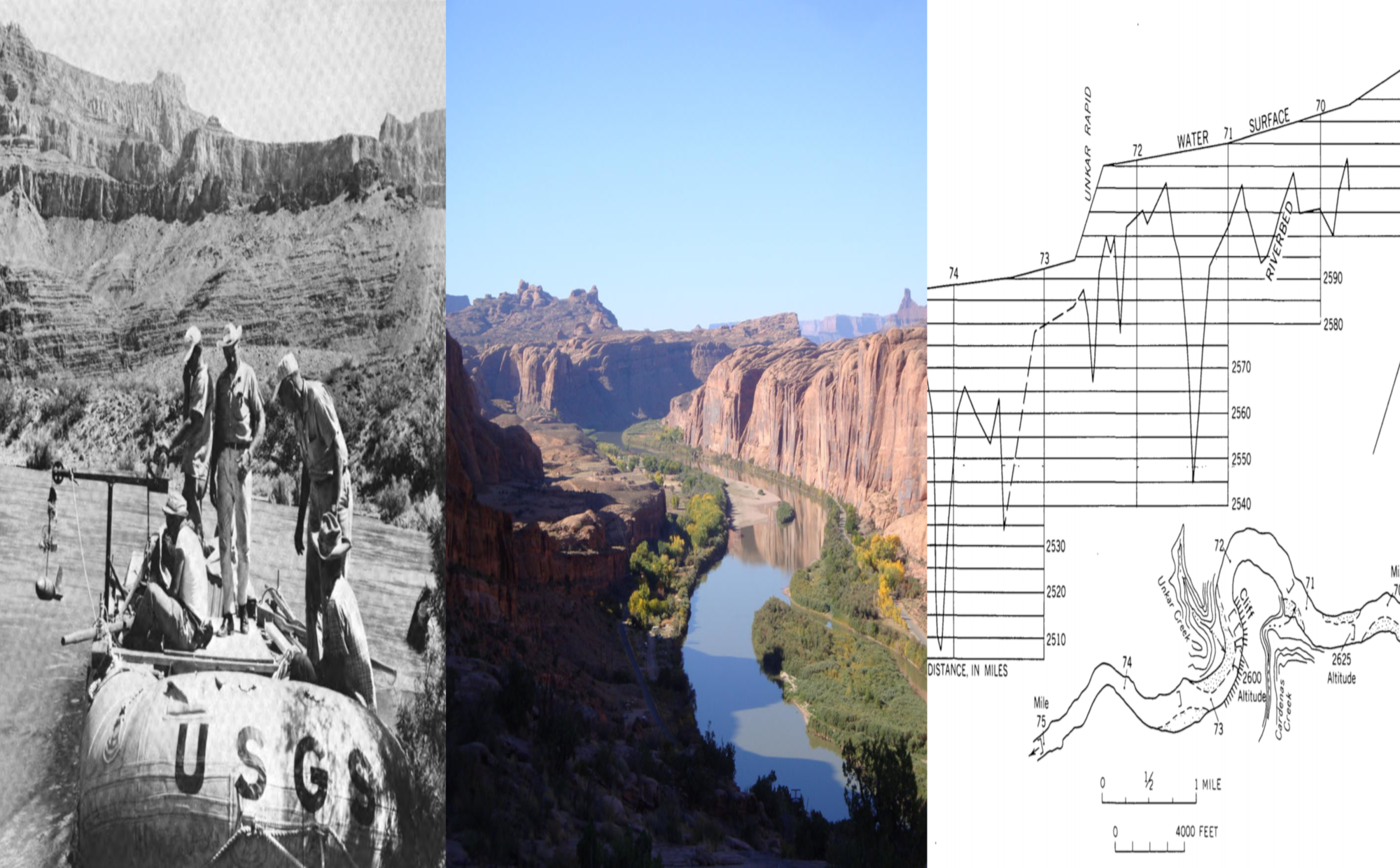Luna Leopold (1915-2006) was a central figure in the development of modern fluvial geomorphology. Trained first as an engineer and meteorologist, Leopold graduated from Harvard with a PhD in geology in 1950. He joined the US Geological Survey that year and worked studying the depth and velocity of rivers–and the particles they carried–developing a methodological approach dubbed hydraulic geometry. By 1957 Leopold was the Survey’s Chief Hydraulic Engineer (a position that was renamed Chief Hydrologist in 1963) and head of its Water Resources Division. Along with M. Gordon Wolman and John P. Miller he published the seminal text Fluvial Processes in Geomorphology in 1964. Fieldwork was essential to Leopold: he had a “flair for recognizing field settings that allow [researchers] to delve into how flowing water shapes landscapes, and how humans alter geomorphic processes.” In 1965, he and a group of fellow researchers floated 300 miles down the Colorado River through the Grand Canyon, charting the forces that had formed the landscape. Leopold left the USGS in 1972 to teach at the University of California, Berkeley. He was awarded the National Medal of Science in 1991.
Publications
2248324
leopold
chicago-fullnote-bibliography
50
544
https://www.riversofdata.org/wp-content/plugins/zotpress/
%7B%22status%22%3A%22success%22%2C%22updateneeded%22%3Afalse%2C%22instance%22%3A%22zotpress-6c8b160775234220aa186b37f647ee3d%22%2C%22meta%22%3A%7B%22request_last%22%3A0%2C%22request_next%22%3A0%2C%22used_cache%22%3Atrue%7D%2C%22data%22%3A%5B%7B%22key%22%3A%22BCIAGBBZ%22%2C%22library%22%3A%7B%22id%22%3A2248324%7D%2C%22meta%22%3A%7B%22creatorSummary%22%3A%22Leopold%22%2C%22parsedDate%22%3A%221969%22%2C%22numChildren%22%3A0%7D%2C%22bib%22%3A%22%3Cdiv%20class%3D%5C%22csl-bib-body%5C%22%20style%3D%5C%22line-height%3A%201.35%3B%20padding-left%3A%201em%3B%20text-indent%3A-1em%3B%5C%22%3E%5Cn%20%20%3Cdiv%20class%3D%5C%22csl-entry%5C%22%3ELeopold%2C%20Luna.%20%3Ci%3EThe%20Rapids%20and%20the%20Pools%20%26%23x2014%3B%20Grand%20Canyon%3C%5C%2Fi%3E.%20Washington%2C%20D.C.%3A%20Geological%20Survey%20Professional%20Paper%20669-D%2C%201969.%3C%5C%2Fdiv%3E%5Cn%3C%5C%2Fdiv%3E%22%2C%22data%22%3A%7B%22itemType%22%3A%22book%22%2C%22title%22%3A%22The%20Rapids%20and%20the%20Pools%20%5Cu2014%20Grand%20Canyon%22%2C%22creators%22%3A%5B%7B%22creatorType%22%3A%22author%22%2C%22firstName%22%3A%22Luna%22%2C%22lastName%22%3A%22Leopold%22%7D%5D%2C%22abstractNote%22%3A%22%22%2C%22date%22%3A%221969%22%2C%22language%22%3A%22%22%2C%22ISBN%22%3A%22%22%2C%22url%22%3A%22%22%2C%22collections%22%3A%5B%5D%2C%22dateModified%22%3A%222020-06-25T16%3A04%3A54Z%22%7D%7D%2C%7B%22key%22%3A%2264PREH4A%22%2C%22library%22%3A%7B%22id%22%3A2248324%7D%2C%22meta%22%3A%7B%22creatorSummary%22%3A%22Leopold%20and%20Wolman%22%2C%22parsedDate%22%3A%221960-06-01%22%2C%22numChildren%22%3A0%7D%2C%22bib%22%3A%22%3Cdiv%20class%3D%5C%22csl-bib-body%5C%22%20style%3D%5C%22line-height%3A%201.35%3B%20padding-left%3A%201em%3B%20text-indent%3A-1em%3B%5C%22%3E%5Cn%20%20%3Cdiv%20class%3D%5C%22csl-entry%5C%22%3ELeopold%2C%20Luna%20B.%2C%20and%20M.%20Gordon%20Wolman.%20%26%23x201C%3BRiver%20Meanders.%26%23x201D%3B%20%3Ci%3EGSA%20Bulletin%3C%5C%2Fi%3E%2071%2C%20no.%206%20%28June%201%2C%201960%29%3A%20769%26%23x2013%3B93.%20%3Ca%20href%3D%27https%3A%5C%2F%5C%2Fdoi.org%5C%2F10.1130%5C%2F0016-7606%281960%2971%5B769%3ARM%5D2.0.CO%3B2%27%3Ehttps%3A%5C%2F%5C%2Fdoi.org%5C%2F10.1130%5C%2F0016-7606%281960%2971%5B769%3ARM%5D2.0.CO%3B2%3C%5C%2Fa%3E.%3C%5C%2Fdiv%3E%5Cn%3C%5C%2Fdiv%3E%22%2C%22data%22%3A%7B%22itemType%22%3A%22journalArticle%22%2C%22title%22%3A%22River%20Meanders%22%2C%22creators%22%3A%5B%7B%22creatorType%22%3A%22author%22%2C%22firstName%22%3A%22Luna%20B.%22%2C%22lastName%22%3A%22Leopold%22%7D%2C%7B%22creatorType%22%3A%22author%22%2C%22firstName%22%3A%22M.%20Gordon%22%2C%22lastName%22%3A%22Wolman%22%7D%5D%2C%22abstractNote%22%3A%22%22%2C%22date%22%3A%221960%5C%2F06%5C%2F01%22%2C%22language%22%3A%22en%22%2C%22DOI%22%3A%2210.1130%5C%2F0016-7606%281960%2971%5B769%3ARM%5D2.0.CO%3B2%22%2C%22ISSN%22%3A%220016-7606%22%2C%22url%22%3A%22https%3A%5C%2F%5C%2Fpubs.geoscienceworld.org%5C%2Fgsa%5C%2Fgsabulletin%5C%2Farticle%5C%2F71%5C%2F6%5C%2F769%5C%2F5195%5C%2Friver-meanders%22%2C%22collections%22%3A%5B%5D%2C%22dateModified%22%3A%222020-06-25T16%3A04%3A38Z%22%7D%7D%2C%7B%22key%22%3A%22DWVB95MN%22%2C%22library%22%3A%7B%22id%22%3A2248324%7D%2C%22meta%22%3A%7B%22creatorSummary%22%3A%22Leopold%20and%20Wolman%22%2C%22parsedDate%22%3A%221957%22%2C%22numChildren%22%3A0%7D%2C%22bib%22%3A%22%3Cdiv%20class%3D%5C%22csl-bib-body%5C%22%20style%3D%5C%22line-height%3A%201.35%3B%20padding-left%3A%201em%3B%20text-indent%3A-1em%3B%5C%22%3E%5Cn%20%20%3Cdiv%20class%3D%5C%22csl-entry%5C%22%3ELeopold%2C%20Luna%20B.%2C%20and%20M.%20Gordon%20Wolman.%20%3Ci%3ERiver%20Channel%20Patterns%3A%20Braided%2C%20Meandering%2C%20and%20Straight%3C%5C%2Fi%3E.%20US%20Government%20Printing%20Office%2C%201957.%3C%5C%2Fdiv%3E%5Cn%3C%5C%2Fdiv%3E%22%2C%22data%22%3A%7B%22itemType%22%3A%22book%22%2C%22title%22%3A%22River%20channel%20patterns%3A%20braided%2C%20meandering%2C%20and%20straight%22%2C%22creators%22%3A%5B%7B%22creatorType%22%3A%22author%22%2C%22firstName%22%3A%22Luna%20B.%22%2C%22lastName%22%3A%22Leopold%22%7D%2C%7B%22creatorType%22%3A%22author%22%2C%22firstName%22%3A%22M.%20Gordon%22%2C%22lastName%22%3A%22Wolman%22%7D%5D%2C%22abstractNote%22%3A%22%22%2C%22date%22%3A%221957%22%2C%22language%22%3A%22%22%2C%22ISBN%22%3A%22%22%2C%22url%22%3A%22%22%2C%22collections%22%3A%5B%5D%2C%22dateModified%22%3A%222020-06-25T16%3A04%3A34Z%22%7D%7D%2C%7B%22key%22%3A%22SMHCNL9I%22%2C%22library%22%3A%7B%22id%22%3A2248324%7D%2C%22meta%22%3A%7B%22creatorSummary%22%3A%22Leopold%20et%20al.%22%2C%22parsedDate%22%3A%221964%22%2C%22numChildren%22%3A1%7D%2C%22bib%22%3A%22%3Cdiv%20class%3D%5C%22csl-bib-body%5C%22%20style%3D%5C%22line-height%3A%201.35%3B%20padding-left%3A%201em%3B%20text-indent%3A-1em%3B%5C%22%3E%5Cn%20%20%3Cdiv%20class%3D%5C%22csl-entry%5C%22%3ELeopold%2C%20Luna%20B.%2C%20M.%20Gordon%20Wolman%2C%20and%20John%20P.%20Miller.%20%3Ci%3EFluvial%20Processes%20in%20Geomorphology%3C%5C%2Fi%3E.%20New%20York%3A%20Dover%2C%201964.%3C%5C%2Fdiv%3E%5Cn%3C%5C%2Fdiv%3E%22%2C%22data%22%3A%7B%22itemType%22%3A%22book%22%2C%22title%22%3A%22Fluvial%20Processes%20in%20Geomorphology%22%2C%22creators%22%3A%5B%7B%22creatorType%22%3A%22author%22%2C%22firstName%22%3A%22Luna%20B.%22%2C%22lastName%22%3A%22Leopold%22%7D%2C%7B%22creatorType%22%3A%22author%22%2C%22firstName%22%3A%22M.%20Gordon%22%2C%22lastName%22%3A%22Wolman%22%7D%2C%7B%22creatorType%22%3A%22author%22%2C%22firstName%22%3A%22John%20P.%22%2C%22lastName%22%3A%22Miller%22%7D%5D%2C%22abstractNote%22%3A%22This%20excellent%20text%20is%20a%20pioneering%20work%20in%20the%20study%20of%20landform%20development%20under%20processes%20associated%20with%20running%20water.%20Its%20primary%20emphasis%20is%20on%20subjects%20that%20were%20the%20focus%20of%20the%20authors%27%20studies%20in%20both%20field%20and%20laboratory.%20Part%20I%20deals%20with%20the%20process%20of%20change%20in%20the%20evolving%20landscape.%20Part%20II%20explores%20process%20and%20form%2C%20and%20Part%20III%2C%20the%20effects%20of%20time.In%20Part%20I%2C%20the%20relation%20of%20geomorphology%20to%20field%20problems%20is%20analyzed%20in%20studies%20of%20a%20mountain%20block%20in%20a%20semiarid%20climate%2C%20a%20meandering%20river%20cut%20into%20bedrock%2C%20and%20benches%20along%20a%20sea%20coast.%20Part%20Two%20contains%20studies%20of%20weathering%2C%20climate%2C%20and%20such%20denudational%20processes%20as%20flooding%20and%20erosion.%20Here%2C%20too%2C%20are%20examinations%20of%20the%20drainage%20basin%20as%20a%20geomorphic%20unit%2C%20water%20and%20sediment%20in%20channels%2C%20channel%20form%20and%20process%2C%20and%20hillslope%20characteristics%20and%20processes.In%20Part%20III%2C%20the%20authors%20cover%20geochronology%2C%20drainage%20pattern%20evolution%2C%20channel%20changes%20with%20time%2C%20and%20the%20evolution%20of%20hillslopes.%20Two%20appendixes%20will%20help%20readers%20convert%20units%20and%20equivalents%2C%20and%20identify%20symbols%20and%20nomenclature.%201964%20edition.%22%2C%22date%22%3A%221964%22%2C%22language%22%3A%22en%22%2C%22ISBN%22%3A%22978-0-486-13973-9%22%2C%22url%22%3A%22%22%2C%22collections%22%3A%5B%5D%2C%22dateModified%22%3A%222020-06-25T16%3A04%3A29Z%22%7D%7D%2C%7B%22key%22%3A%22ADM58W2E%22%2C%22library%22%3A%7B%22id%22%3A2248324%7D%2C%22meta%22%3A%7B%22creatorSummary%22%3A%22Leopold%20et%20al.%22%2C%22parsedDate%22%3A%221960%22%2C%22numChildren%22%3A0%7D%2C%22bib%22%3A%22%3Cdiv%20class%3D%5C%22csl-bib-body%5C%22%20style%3D%5C%22line-height%3A%201.35%3B%20padding-left%3A%201em%3B%20text-indent%3A-1em%3B%5C%22%3E%5Cn%20%20%3Cdiv%20class%3D%5C%22csl-entry%5C%22%3ELeopold%2C%20Luna%20B.%2C%20R.%20A.%20Bagnold%2C%20M.%20Gordon%20Wolman%2C%20and%20Lucien%20M.%20Brush.%20%26%23x201C%3BFlow%20Resistance%20in%20Sinuous%20Or%20Irregular%20Channels%2C%26%23x201D%3B%201960.%3C%5C%2Fdiv%3E%5Cn%3C%5C%2Fdiv%3E%22%2C%22data%22%3A%7B%22itemType%22%3A%22journalArticle%22%2C%22title%22%3A%22Flow%20Resistance%20in%20Sinuous%20Or%20Irregular%20Channels%22%2C%22creators%22%3A%5B%7B%22creatorType%22%3A%22author%22%2C%22firstName%22%3A%22Luna%20B.%22%2C%22lastName%22%3A%22Leopold%22%7D%2C%7B%22creatorType%22%3A%22author%22%2C%22firstName%22%3A%22R.%20A.%22%2C%22lastName%22%3A%22Bagnold%22%7D%2C%7B%22creatorType%22%3A%22author%22%2C%22firstName%22%3A%22M.%20Gordon%22%2C%22lastName%22%3A%22Wolman%22%7D%2C%7B%22creatorType%22%3A%22author%22%2C%22firstName%22%3A%22Lucien%20M.%22%2C%22lastName%22%3A%22Brush%22%7D%5D%2C%22abstractNote%22%3A%22%22%2C%22date%22%3A%221960%22%2C%22language%22%3A%22en%22%2C%22DOI%22%3A%22%22%2C%22ISSN%22%3A%22%22%2C%22url%22%3A%22%22%2C%22collections%22%3A%5B%5D%2C%22dateModified%22%3A%222020-06-25T16%3A04%3A26Z%22%7D%7D%5D%7D
Leopold, Luna. The Rapids and the Pools — Grand Canyon . Washington, D.C.: Geological Survey Professional Paper 669-D, 1969.
Leopold, Luna B., and M. Gordon Wolman. “River Meanders.”
GSA Bulletin 71, no. 6 (June 1, 1960): 769–93.
https://doi.org/10.1130/0016-7606(1960)71[769:RM]2.0.CO;2 .
Leopold, Luna B., and M. Gordon Wolman. River Channel Patterns: Braided, Meandering, and Straight . US Government Printing Office, 1957.
Leopold, Luna B., M. Gordon Wolman, and John P. Miller. Fluvial Processes in Geomorphology . New York: Dover, 1964.
Leopold, Luna B., R. A. Bagnold, M. Gordon Wolman, and Lucien M. Brush. “Flow Resistance in Sinuous Or Irregular Channels,” 1960.

